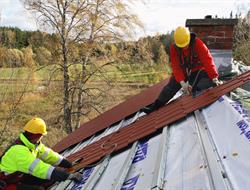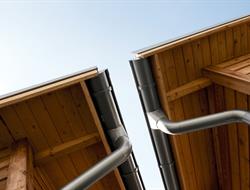Ruukki manufactures sandwich panels at its Alajärvi plant in Finland and at the Oborniki plant in Poland. Sandwich panels are prefabricated wall elements that consist of two thin steel sheets with an insulating layer between them. Regardless of the panel’s manufacturing location or its insulation material, high quality is the primary requirement for production.
High quality of raw materials reflected in the final product
Steel sheets, mineral wool and glue are the raw materials used in Ruukki’s Alajärvi panel plant. There are alternative suppliers for important raw materials, which ensures the availability of raw materials in all situations and contribute to cost-effectiveness.
“Consistent high quality of the raw material, reliable deliveries at the agreed time and flexibility according to the production situation are the factors that affects how we select our suppliers”, says Mervi Pokela, who is in charge of quality at the Alajärvi panel factory.
The quality of all raw materials and components is monitored in both the Alajärvi and Oborniki plants. In addition to checking the quality on arrival, there must be relevant documents showing that the products comply with Ruukki’s requirements. Tests, visual inspections and measurements during the manufacturing process are part of the routines of both plants.
Traceability and quality control
The quality criteria for the panels are based on the applicable technical requirements. During production, Ruukki’s production supervisors, operators, warehouse staff and laboratory staff are responsible for ensuring that these requirements are met. Tomasz Sawicki, who is in charge of quality control at the Oborniki plant, says that the quality requirements are also available in the workstation’s instructions and their fulfilment must be recorded in the electronic quality control system.
“Quality assurance and quality control ensure quality at Ruukki. Our main task is to guarantee that customers’ expectations of product quality are met. In addition to control, quality is constantly being developed in all related areas,” says Sawicki.
If quality deviations occur the defective panels can be traced with the order number and production date printed on them. The advantage of tracing is that it determines the root cause and allows the fault to be corrected. But what if the raw material is the cause of the quality deviation?
“All raw materials can also be traced, as well as any products where the problem might occur. Traceability is mandatory according to current product standards”, explains Pokela.
Certificates as a guarantee of quality
“A certificate is an assurance of the quality and that the product meets the regulations and the requirements that the customer has set for it. Certification benefits our customers. For example, a CE-marking and a declaration of performance simplify the comparison of products from different manufacturers. There are benefits of voluntary certificates as well. For example, FM approvals related to fire safety bring benefits to the customer in insurance matters”, says Elzbieta Plaza, who is in charge of Ruukki’s certification and approvals process.
Most of Ruukki’s products are CE-marked, which is an EU-wide declaration that the product complies with the applicable directive. Ruukki has a certificate for the level of fire protection and a hygiene certificate required by the food industry. In addition to these, Ruukki also has numerous other certificates needed to meet local requirements. Each product group has its own procedures, methods and tests for product certification. Some of the certificates are mandatory and legislative and some are voluntary.
The criteria for certifications for products and processes come from relevant standards, regulations or the requirements of the certifying organisations, amongst other sources.
A certificate for a product is obtained when it meets the criteria set for it, which is confirmed by testing the product in an independent laboratory. When Ruukki tests a product itself, the test result must be clear enough to be valid and must be recorded in a certification document that is also available to customers.
Product development takes the customer into account
According to Ruukki’s head of technology, Jyrki Kesti, regardless of whether the product is completely new or upgraded the decisive factor Ruukki's chief technology Jyrki Kesti says that quality is a passion for product development. Success in this regard is reflected in high customer satisfaction and a low number of complaints.
“Quality does not automatically mean more expensive components and products. High quality can be achieved by various means, for example by careful product and production design. Due to the use of more expensive raw materials, quality sometimes costs more, but when the entire product life cycle is taken into account the customer can benefit from higher quality in the form of reduced maintenance costs, for instance.”
Ruukki’s product development leads to the introduction of features that benefit the customer. For example, customers’ energy costs have been lowered due to Ruukki’s exceptionally strict criteria for the airtightness of sandwich panels.











.tmb-250x190.jpg?sfvrsn=607438b5_1)






